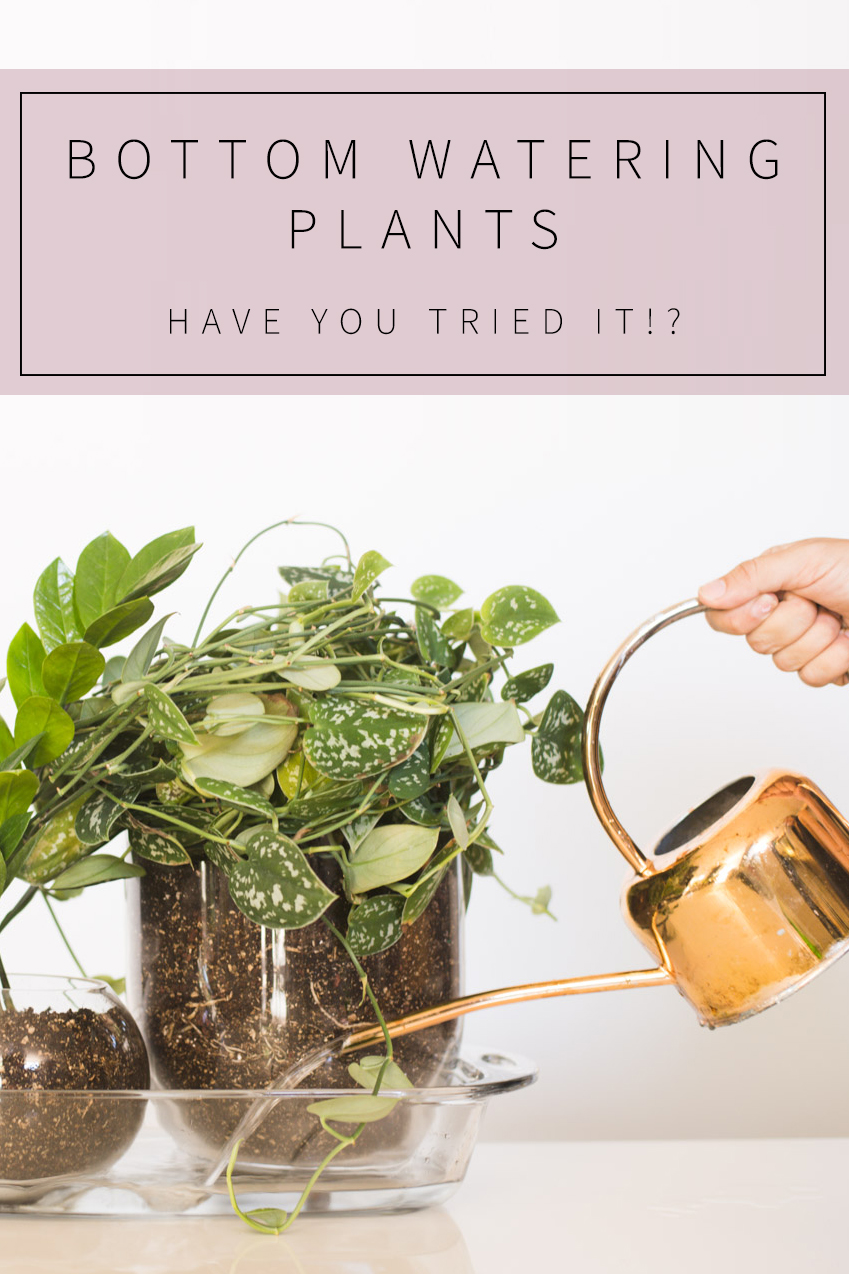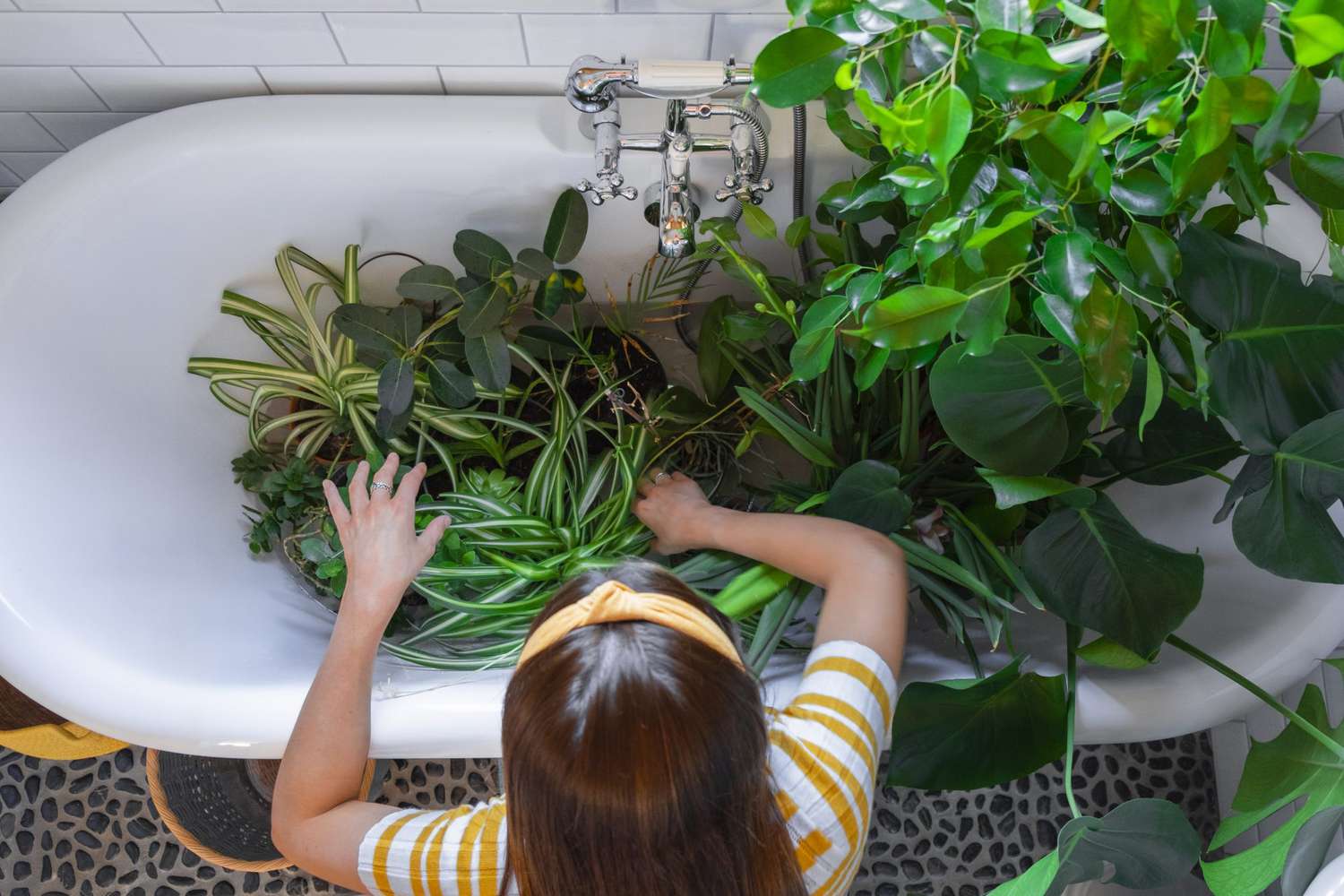Yes, you should water house plants from the bottom. This method ensures even moisture distribution and promotes healthier root growth.
Bottom watering involves placing the plant pot in a shallow tray of water, allowing the soil to absorb moisture through drainage holes. This technique prevents overwatering and reduces the risk of fungal diseases. It encourages roots to grow downward, leading to a more robust and resilient plant.
Bottom watering is especially beneficial for plants sensitive to wet foliage, such as African violets. Always monitor the water level and remove the pot once the soil is adequately moist. Regularly practicing bottom watering can lead to healthier, thriving house plants, making it an effective and efficient watering method.

Credit: vintagerevivals.com
Introduction To Bottom Watering
Keeping houseplants healthy can be challenging. One effective technique is bottom watering. This method ensures plants get the right amount of water.
What Is Bottom Watering?
Bottom watering is a way to hydrate plants. Instead of pouring water on the soil, you let the plant absorb it from the bottom.
This method involves placing the plant pot in a tray or sink filled with water. The water seeps up through the drainage holes, reaching the roots.
| Method | Description |
|---|---|
| Top Watering | Pouring water directly on soil surface. |
| Bottom Watering | Soaking water from the tray or sink. |
Why Consider Bottom Watering?
Bottom watering offers many benefits for houseplants. Here are some reasons to try this method:
- Prevents Overwatering: Roots only absorb what they need.
- Promotes Healthy Root Growth: Encourages roots to grow downwards.
- Reduces Fungal Growth: Keeps the soil surface dry.
Bottom watering can be a good option for many plants. It helps ensure they get the right amount of moisture.
Benefits Of Bottom Watering
Bottom watering is a popular method for watering house plants. It offers many benefits. This method can help keep your plants healthy. It can also prevent common problems like root rot.
Prevents Overwatering
Bottom watering allows your plants to absorb water from below. This helps prevent overwatering. Overwatering is a common issue with house plants. It can lead to root rot and other problems.
When you water from the top, excess water can sit in the soil. This can make the roots too wet. Bottom watering helps the plant take only the water it needs. This reduces the risk of overwatering.
Encourages Root Growth
Bottom watering encourages healthy root growth. Roots grow downwards to reach the water. This makes the roots stronger and healthier.
Stronger roots mean a healthier plant. A healthy root system can absorb nutrients better. This helps the plant grow well.
Here is a simple comparison table:
| Top Watering | Bottom Watering |
|---|---|
| Risk of Overwatering | Prevents Overwatering |
| Roots may stay near the surface | Encourages Deep Root Growth |
Bottom watering can be a great way to care for your house plants. It helps prevent overwatering and encourages root growth. Try it and see how your plants thrive!
Drawbacks Of Bottom Watering
Bottom watering has its benefits, but there are drawbacks too. Understanding these can help you decide the best watering method for your houseplants.
Potential For Salt Build-up
Bottom watering can cause salt build-up in the soil. Salts from fertilizers accumulate over time. Without top watering, these salts don’t get flushed out.
Salt build-up can harm plant roots. This leads to poor growth and yellow leaves. Plants need regular top watering to remove excess salts.
To prevent salt build-up, use distilled or rainwater. These types of water have fewer salts and chemicals.
Not Suitable For All Plants
Not all plants like bottom watering. Some plants prefer their roots to dry out between waterings. Bottom watering keeps soil too moist for these plants.
Cacti and succulents need dry soil. Bottom watering can rot their roots. It’s better to water these plants from the top.
Plants with fine roots can also suffer. The water may not reach all roots evenly. This can cause uneven growth and health problems.
| Plant Type | Watering Preference |
|---|---|
| Cacti and Succulents | Top Watering |
| Plants with Fine Roots | Top Watering |
| Plants with Thick Roots | Bottom Watering |
How To Bottom Water Your Plants
Bottom watering is a smart way to keep houseplants healthy. This method ensures the roots get enough water without overwatering. It’s perfect for plants sensitive to wet leaves. Follow our guide to learn how to bottom water your plants.
Step-by-step Guide
- Choose the right container: Pick a container that can hold your plant pot.
- Fill with water: Add water to the container until it reaches halfway up the pot.
- Place the plant: Put the plant pot in the container. Ensure the water touches the drainage holes.
- Wait: Leave the plant in the water for 15-30 minutes. The soil will absorb the water.
- Check moisture: Touch the top of the soil. If it’s moist, remove the plant from the water.
- Drain excess water: Let the plant pot drain fully before putting it back in its spot.
Tools You Need
- Container: A bowl or basin large enough to hold your plant pot.
- Water: Use room temperature water for best results.
- Timer: Use a timer to keep track of soaking time.
- Moisture meter: Optional but helpful for checking soil moisture levels.
| Tool | Purpose |
|---|---|
| Container | Holds the water and plant pot |
| Water | Needed for bottom watering |
| Timer | Tracks soaking time |
| Moisture meter | Checks soil moisture |
Bottom watering is simple and effective. Your plants will thrive with this method.
Best Practices For Bottom Watering
Bottom watering can be an excellent method for house plants. It helps ensure that plants get the water they need without over-watering. Here are some best practices to follow for bottom watering.
Frequency Of Watering
Understanding the frequency of bottom watering is vital. It depends on the type of plant and soil. Most indoor plants need watering every 7-10 days. Use a schedule to keep track. Check the soil moisture before watering. A moisture meter can help.
| Plant Type | Watering Frequency |
|---|---|
| Succulents | Every 10-14 days |
| Ferns | Every 5-7 days |
| Peace Lily | Every 7-10 days |
Signs Your Plant Needs Water
Knowing the signs that your plant needs water is crucial. Look for these signs:
- Soil is dry to the touch.
- Leaves are wilting or drooping.
- Leaf edges turning brown.
- Plant looks less vibrant.
Check the soil with a finger. If it feels dry, it’s time to water. Use a moisture meter for accuracy.
Common Mistakes To Avoid
Watering house plants from the bottom can be a great technique. But, there are common mistakes that can harm your plants. Let’s explore these mistakes to ensure your plants thrive.
Using Hard Water
Many people use hard water for their plants. This can be problematic. Hard water contains minerals like calcium and magnesium. These minerals can build up in the soil.<p
This buildup can harm your plant roots. Soft water or filtered water is better. You can also let tap water sit for 24 hours. This allows some minerals to evaporate.
Ignoring Plant Needs
Each plant has different needs. Some plants need more water. Others need less. It’s important to know your plant’s specific requirements.
Don’t assume all plants are the same. Research your plant type. Adjust your watering method accordingly. This helps your plant stay healthy and strong.
“`Plants That Benefit Most From Bottom Watering
Bottom watering is a great way to give plants the moisture they need. It allows the roots to soak up water from the base. This method helps prevent over-watering and root rot. Some plants benefit more from bottom watering than others. Here, we will explore these plants in detail.
Succulents And Cacti
Succulents and cacti thrive in dry conditions. They have thick, fleshy leaves that store water. Bottom watering helps them absorb just the right amount of moisture. This method reduces the risk of over-watering. It keeps the soil dry on the surface, which is ideal for these plants.
- Avoids root rot: The soil remains dry on the top, preventing rot.
- Water absorption: Roots absorb water efficiently from the base.
- Prevents over-watering: Only the necessary amount of water is absorbed.
Tropical Plants
Tropical plants love a humid environment. They need consistent moisture but hate soggy roots. Bottom watering ensures they get enough water without drowning the roots. This method helps maintain the right moisture level.
| Benefit | Description |
|---|---|
| Prevents root rot | Soil remains moist but not wet. |
| Consistent moisture | Roots get a steady supply of water. |
| Ideal for large leaves | Promotes healthy growth of broad leaves. |
Consider bottom watering for these plants for better growth. It provides a balanced environment for their roots.

Credit: www.reddit.com
Expert Tips For Bottom Watering
Bottom watering is a great method for house plants. It helps roots grow strong. This section covers expert tips for bottom watering. It includes monitoring soil moisture and adjusting based on season.
Monitor Soil Moisture
Check soil moisture before bottom watering. Use a moisture meter for accuracy. Insert the meter into the soil. Read the display to know moisture level. Ensure the soil is not too dry or too wet.
Testing with your finger works too. Stick your finger one inch into the soil. Feel if the soil is dry or moist. If it’s dry, it’s time to water.
Bottom watering helps avoid overwatering. It allows plants to take up only what they need. This method helps prevent root rot.
Adjust Based On Season
Seasons affect plant water needs. In summer, plants need more water. Soil dries out faster in heat. Check soil moisture more often.
In winter, plants need less water. Soil stays moist longer in cool weather. Reduce watering frequency to avoid soggy soil.
Keep plants in well-lit areas in winter. This helps them grow even with less water. Adjust watering habits as seasons change.
Below is a table summarizing seasonal watering adjustments:
| Season | Watering Frequency | Soil Moisture Check |
|---|---|---|
| Summer | More often | Check frequently |
| Winter | Less often | Check less frequently |
Following these tips ensures healthy plants. Happy bottom watering!
:max_bytes(150000):strip_icc()/GettyImages-1186947443-9f149554de454d8bb9ad5e905ab23dfd.jpg)
Credit: www.thespruce.com
Frequently Asked Questions
Should You Water Houseplants From Top Or Bottom?
Water houseplants from the bottom to encourage deeper root growth. Top watering can lead to shallow roots and mold.
Can You Overwater By Bottom Watering?
Yes, you can overwater by bottom watering. Ensure the plant has proper drainage and only water when the soil is dry.
What Plants Should Not Be Bottom Watered?
Avoid bottom watering for plants like cacti, succulents, and orchids. These plants prefer top watering. Ensure proper drainage to prevent root rot.
Am I Over Or Under Watering My House Plants?
Check soil moisture. Dry soil indicates under-watering, while soggy soil suggests over-watering. Yellow leaves can signal both issues.
Conclusion
Bottom watering can be a great method for house plants. It ensures even moisture distribution and healthier roots. Remember to assess your plant’s specific needs. Some plants may still prefer top watering. Experiment to find the best approach. Happy gardening!

My mission is to help you bring the beauty of nature indoors with expert advice, detailed plant care guides, and creative design ideas.





Leave a Reply